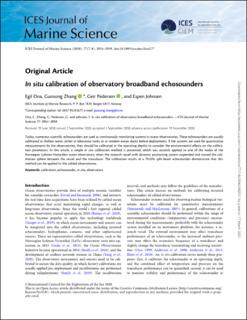| dc.contributor.author | Ona, Egil | |
| dc.contributor.author | Zhang, Guosong | |
| dc.contributor.author | Pedersen, Geir | |
| dc.contributor.author | Johnsen, Espen | |
| dc.date.accessioned | 2021-04-26T11:45:10Z | |
| dc.date.available | 2021-04-26T11:45:10Z | |
| dc.date.created | 2021-03-17T11:03:43Z | |
| dc.date.issued | 2020 | |
| dc.identifier.citation | ICES Journal of Marine Science. 2020, 77 (7-8), 2954-2959. | en_US |
| dc.identifier.issn | 1054-3139 | |
| dc.identifier.uri | https://hdl.handle.net/11250/2739589 | |
| dc.description.abstract | Today, numerous scientific echosounders are used as continuously monitoring systems in ocean observatories. These echosounders are usually calibrated in shallow water, either in laboratory tanks or at random ocean docks before deployments. If the systems are used for quantitative measurements by the observatories, they should be calibrated at the operating depths to consider the environmental effects on the calibration parameters. In this article, a simple in situ calibration method is presented, which was recently applied to one of the nodes of the Norwegian Lofoten-Vesterålen ocean observatory, when the research vessel with dynamic positioning system suspended and moved the calibration sphere between the vessel and the transducer. The calibration results of a 70-kHz split-beam echosounder demonstrate that this method can be applied to the cabled observatories. | en_US |
| dc.language.iso | eng | en_US |
| dc.title | In situ calibration of observatory broadband echosounders | en_US |
| dc.type | Peer reviewed | en_US |
| dc.type | Journal article | en_US |
| dc.description.version | publishedVersion | en_US |
| dc.source.pagenumber | 2954-2959 | en_US |
| dc.source.volume | 77 | en_US |
| dc.source.journal | ICES Journal of Marine Science | en_US |
| dc.source.issue | 7-8 | en_US |
| dc.identifier.doi | 10.1093/icesjms/fsaa177 | |
| dc.identifier.cristin | 1898583 | |
| dc.relation.project | Norges forskningsråd: 309512 | en_US |
| cristin.ispublished | true | |
| cristin.fulltext | original | |
| cristin.qualitycode | 1 | |
